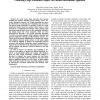Free Online Productivity Tools
i2Speak
i2Symbol
i2OCR
iTex2Img
iWeb2Print
iWeb2Shot
i2Type
iPdf2Split
iPdf2Merge
i2Bopomofo
i2Arabic
i2Style
i2Image
i2PDF
iLatex2Rtf
Sci2ools
ICDM
2010
IEEE
2010
IEEE
Clustering Large Attributed Graphs: An Efficient Incremental Approach
In recent years, many networks have become available for analysis, including social networks, sensor networks, biological networks, etc. Graph clustering has shown its effectiveness in analyzing and visualizing large networks. The goal of graph clustering is to partition vertices in a large graph into clusters based on various criteria such as vertex connectivity or neighborhood similarity. Many existing graph clustering methods mainly focus on the topological structures, but largely ignore the vertex properties which are often heterogeneous. Recently, a new graph clustering algorithm, SA-Cluster, has been proposed which combines structural and attribute similarities through a unified distance measure. SACluster performs matrix multiplication to calculate the random walk distances between graph vertices. As the edge weights are iteratively adjusted to balance the importance between structural and attribute similarities, matrix multiplication is repeated in each iteration of the cluster...
| Added | 12 Feb 2011 |
| Updated | 12 Feb 2011 |
| Type | Journal |
| Year | 2010 |
| Where | ICDM |
| Authors | Yang Zhou, Hong Cheng, Jeffrey Xu Yu |
Comments (0)

